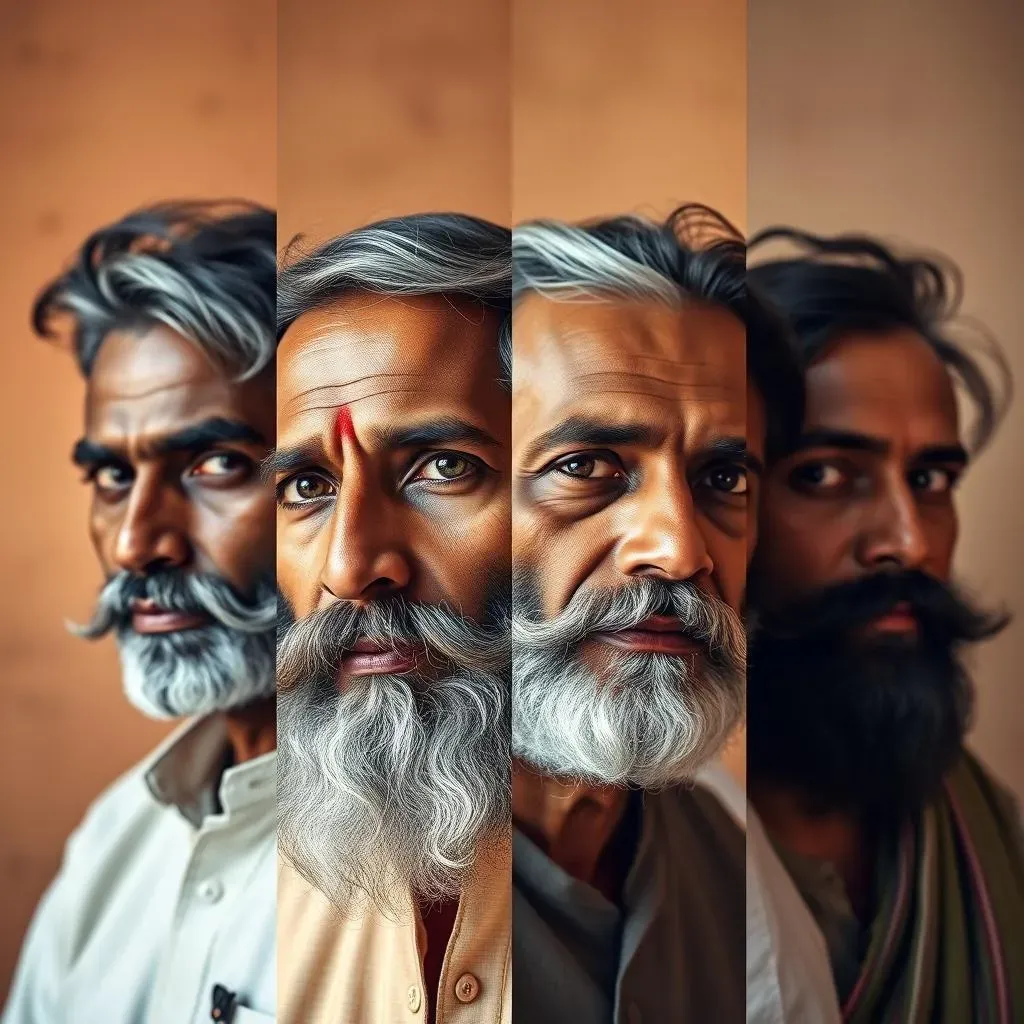Table of Contents
Ever wondered why some Indian men sport magnificent beards while others struggle to grow even a decent mustache? The answer lies partly in the fascinating world of Indian beard genetics. This article embarks on a journey to explore the science behind this captivating topic. We'll delve into the intricate genetic mechanisms that determine beard growth, examining how variations within these genes contribute to the diverse range of beard types seen across different Indian populations. We'll also explore the interplay between genetics and environmental factors – from diet and lifestyle to hormonal influences – in shaping beard development. Understanding Indian beard genetics isn't just about appreciating the aesthetics; it opens a window into our complex genetic heritage and how it manifests in unique physical characteristics. Prepare to unravel the mysteries surrounding Indian beard genetics and discover the factors that contribute to this striking aspect of male identity. Get ready to gain a deeper appreciation for the science behind those impressive beards!
The Science Behind Indian Beard Genetics
The Science Behind Indian Beard Genetics
The Role of Genes
So, you're diving into the world of Indian beard genetics? That's awesome! It's a complex topic, but incredibly fascinating. Think of it like this: your genes are like a blueprint for your body, and they dictate everything from your eye color to, you guessed it, your beard growth potential. Specific genes control hair follicle development, hair growth cycles, and even the thickness and color of your beard hair. Some men inherit genes that promote robust beard growth, resulting in thick, full beards, while others inherit genes that lead to sparser growth. It's all in the genes, my friend. Want to learn more about different beard styles? Check out our guide to Indian beard styles.
And it’s not just one gene; it's a whole orchestra of genes working together. Think of it as a complex recipe – you need the right balance of ingredients (genes) to get the desired outcome (a full beard). Researchers are still uncovering the specific genes involved, but we know that variations in these genes, even tiny ones, can dramatically impact beard growth. The good news is that research is ongoing, and we're learning more every day about the genetic secrets behind beard growth. For example, some genes influence the sensitivity of hair follicles to hormones like testosterone, which plays a significant role in beard development. Did you know that maintaining a proper beard care routine is crucial? Learn more about Indian beard maintenance.
Gene | Potential Influence on Beard Growth |
|---|---|
Gene X (hypothetical) | Hair follicle development |
Gene Y (hypothetical) | Hair growth cycle length |
Gene Z (hypothetical) | Hair thickness and color |
Hormonal Influences and Environmental Factors
But wait, there's more! While genes lay the foundation, they don't tell the whole story. Hormones, particularly testosterone, play a starring role in beard growth. Testosterone stimulates the hair follicles, prompting them to produce longer, thicker hairs. Levels of testosterone can vary due to factors like age, overall health, and even seasonal changes. This explains why some men might see their beard growth improve as they age or after changes in their lifestyle. Think of testosterone as the conductor of the genetic orchestra – it ensures that the genes are working in harmony to create a full, lush beard. If you're interested in styling your beard for a special occasion, check out our tips on Indian beard styles for parties.
Beyond genes and hormones, environmental factors can also influence beard growth. Things like nutrition, stress levels, and overall health can affect hormone production and hair follicle function. For example, a diet lacking essential nutrients can hinder beard growth. Similarly, chronic stress can disrupt hormone balance, potentially impacting beard development. It's a holistic system, you see. It's not just about genetics; it's about the interplay between genes, hormones, and lifestyle. So, while your genetic makeup sets the stage, your lifestyle choices can either enhance or hinder your beard's potential. Looking for inspiration from Bollywood? Check out our article on ultimate Indian actors' beard styles!
- Testosterone levels
- Nutrition
- Stress levels
- Overall health
Variations in Beard Growth Across Indian Subgroups
Variations in Beard Growth Across Indian Subgroups
Regional Differences in Beard Growth
Now, this is where things get really interesting! India's incredible diversity extends to its men's beards too. You won't find a single "Indian beard type." There are significant regional variations in beard growth patterns, influenced by a mix of genetic factors and historical migration patterns. For example, you might find that certain communities in the South exhibit different beard growth patterns compared to those in the North. This isn't just about thickness; it also encompasses beard color, texture, and even the way the beard grows on the face. Think of it like a delicious tapestry woven from the threads of many different genetic lineages.
These variations aren't random; they reflect the complex genetic history of the Indian subcontinent. Over centuries, different populations have migrated, intermingled, and adapted to their environments. This has led to a rich mosaic of genetic traits, and beard growth is just one piece of this fascinating puzzle. Want to explore different beard styles tailored to your facial features? Check out our guide on beard styles for oval faces.
Region | Observed Beard Growth Trends (Generalizations) |
|---|---|
North India | Often thicker, fuller beards |
South India | Potentially more variations, including lighter or sparser beards |
East India | May show a blend of northern and southern influences |
West India | Regional variations may be observed |
Genetic Ancestry and Beard Traits
Let's zoom in on the genetic aspect. The variations we see in beard growth across different Indian subgroups are often linked to their genetic ancestry. Different populations carry different combinations of genes influencing hair growth, resulting in the unique beard characteristics we observe. Some populations might have a higher frequency of genes that promote thicker hair growth, leading to fuller beards. Others may have a different genetic makeup, resulting in lighter or sparser growth. It's all about the specific genetic cocktail each individual inherits.
Think of it like a recipe again – different ingredients (genes) create different dishes (beard types). Further research is needed to pinpoint the exact genes responsible for these variations, but it's clear that genetic ancestry plays a significant role. Understanding these genetic influences can help us appreciate the diversity of beard growth patterns within India and how they reflect the rich tapestry of Indian heritage. Are you curious about how to style a full beard? We have a guide on full beard styles for Indian men.
- Genetic diversity across Indian populations
- Influence of ancestral lineages on beard traits
- Further research needed to identify specific genes
Factors Influencing Indian Beard Growth: Genetics and Environment
So, we've talked genes, but let's not forget the environment plays a huge role too! Think of your genes as the blueprint, but the environment is the construction crew – it shapes how that blueprint is actually built. Factors like nutrition are super important. A diet rich in protein, vitamins, and minerals fuels hair growth, while deficiencies can lead to thinner, weaker beards. Imagine trying to build a house with substandard materials – it's not going to be pretty! Similarly, chronic stress can wreak havoc on your hormones, potentially impacting beard growth. Stress throws everything out of whack, including your body's ability to produce testosterone, the key player in beard development. Want to explore products that can help boost your beard growth? Check out our guide on Indian beard products.
- Nutritional deficiencies can hinder beard growth.
- Chronic stress disrupts hormone balance.
- Hormonal imbalances can affect beard thickness and growth.
Beyond diet and stress, other environmental factors can also influence beard growth. Things like pollution, exposure to certain chemicals, and even sleep quality can affect hair follicle health. It's all interconnected. Think of your body as a finely tuned machine – every part needs to be working optimally for peak performance, including your beard! And don't forget about age. Beard growth often changes throughout a man's life, influenced by hormonal fluctuations that occur naturally with aging. Want to learn more about beard styles for different age groups? Check out our guide on beard styles for older Indian men.
Environmental Factor | Potential Impact on Beard Growth |
|---|---|
Nutrition (protein, vitamins, minerals) | Promotes or hinders growth |
Stress | Can disrupt hormone balance, reducing growth |
Pollution & Chemicals | Can damage hair follicles |
Sleep Quality | Affects overall health and hormone regulation |
Understanding Indian Beard Genetics: Implications and Future Research
So, what does all this mean? Understanding Indian beard genetics has broader implications beyond just satisfying our curiosity about why some men have amazing beards and others don't. This knowledge can inform the development of new hair care products and treatments tailored to specific genetic profiles. Imagine personalized beard growth serums designed to optimize your beard's potential based on your unique genetic makeup! It's not science fiction; it's the future of beard care. Plus, this research could have implications for forensic science, aiding in the creation of more accurate DNA-based facial reconstructions. Pretty cool, huh? Want to know more about enhancing your beard's appearance? Check out our guide to Indian beard and hair styling.
- Personalized beard care products
- Advancements in forensic science
- Improved understanding of hair growth disorders
Looking ahead, future research should focus on identifying specific genes and genetic variations that influence beard growth in diverse Indian populations. This involves large-scale genetic studies that consider the incredible genetic diversity within India. We also need to better understand the complex interplay between genes, hormones, and environmental factors. This requires a multidisciplinary approach, bringing together geneticists, endocrinologists, dermatologists, and other experts. The more we understand, the better we can personalize beard care and address potential hair growth problems. Think of it like unlocking the secrets of a hidden treasure map – each discovery brings us closer to understanding the complete picture. For more on achieving the perfect beard, check out our article on the best Indian beard styles.
Research Area | Potential Outcomes |
|---|---|
Gene identification | Development of targeted treatments |
Gene-environment interaction | Personalized lifestyle recommendations |
Large-scale genetic studies | Comprehensive understanding of beard growth variations |